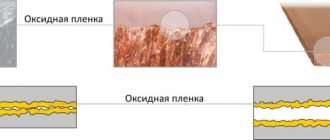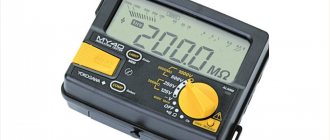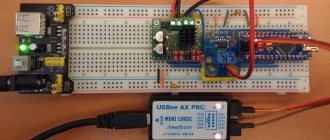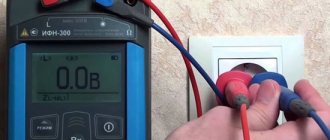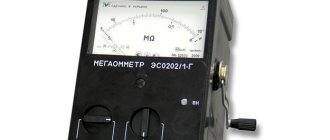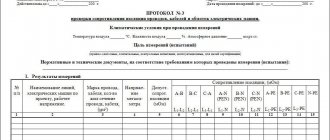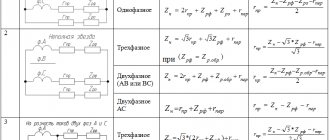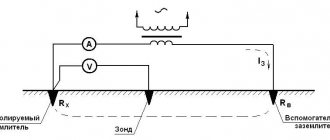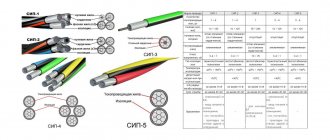Upon completion of the installation of electrical equipment, as well as during its operation, it is necessary to carry out a set of electrical measuring measures, among which there is also such a type of test as checking metal connections. What is metal bonding and what is the purpose of measurement, we will analyze further.
Servicing electrical installations is permitted only to personnel who have undergone special training and knowledge testing. The qualifications of specialists are confirmed by certificates of the appropriate type. There are also separate requirements for the equipment itself - climatic design, installation method, safe operating conditions and other aspects that require strict compliance. These include the presence of protective grounding on metal cases.
What is metal communication
The definition of “metal bond” among electricians characterizes the presence and quality of protective grounding. Checking metal connections means determining the transient ohmic resistance between the ground loop and the grounded electrical equipment.
For this purpose, the third core in the wiring of private houses (apartments) and the fifth core in the electrical networks of industrial enterprises are specially included in power supply projects to organize the TN-CS system - the most common grounding system in electrical installations up to 1000V today.
Nuances
Metal bond measurements are carried out immediately after installation, right before start-up and operation, and then, at intervals of 3 years, during routine testing and maintenance. Along with the check, as well as when the season changes, when flooding and excessive humidity are possible, the insulation resistance of cables and electrical machines is checked.
It will not be possible to check the quality of the contact and measure its contact resistance using a simple household multimeter, such as DT830 and the like. In the region of low resistances, they either do not measure at all (up to tenths, but not hundredths of an ohm), and the resistance between the probes alone reaches 1 ohm, and sometimes exceeds. There is no need to talk about accuracy here.
Sometimes, to measure the quality of a contact, instruments are not needed, since its destruction is obvious. In extreme cases, it comes to the point that you can measure its temperature with your hand; if it gets hot, then it needs preventive maintenance and subsequent measurements and testing with a milliohmmeter.
Finally, we recommend watching a video that clearly shows how to check the presence of metal connections with the device:
Checking metal communications is very important for the life safety of enterprise employees and house residents. Due to poor grounding in sockets or its complete absence, there is a possibility of potential appearing on the device body. And when a person touches it, either electrical injury or something irreparable will occur. We hope the information provided was useful and interesting for you!
Source
Purpose of metal bond measurements
The purpose of checking metal connections is to determine the parameters of grounding circuits that characterize the electrical safety of the installation.
Based on the fact that in the event of an emergency mode (breakdown of the insulation of current-carrying parts), the current will follow the path of least electrical resistance, the Electrical Installation Rules (PUE) establish strict standards for the cross-section of grounding conductors and the value of transition resistance. The resistance of one connection (contact) should be equal to no more than 0.01 Ohm with an error of up to 20%, however, for grounding, at least two connections (welded or bolted) along with the conductor are required, therefore employees of the electrical engineering laboratory (ETL) when making measurements are based on the value of the total transition resistance is 0.05 Ohm.
Contact the specialists
Regular checks of the integrity of grounding loops by certified specialists are a guarantee of the safety of enterprise employees, lower operating costs by reducing “waste” energy consumption and reducing the risk of fire.
Employees will conduct an examination of the electrical circuit elements to which access has been granted. Using precision instruments, the transition resistance will be measured, the readings will be recorded in a protocol and transferred to the Customer.
During testing, equipment is not excluded from the work process, so testing metal communications does not affect the productivity of the enterprise. The work is carried out in a short time and at an affordable cost.
Test frequency
After the start of operation of electrical equipment, engineering and technical workers responsible for electrical equipment, in accordance with the requirements of PTEEP (Rules for the Technical Operation of Consumer Electrical Installations), carry out repeated measurements of metal connections at least once every 3 years (clause 2.12.17). This is due to the fact that over time, the appearance of oxides, dust, weakening of contacts and a number of other factors leads to a gradual increase in ohmic resistance, and it is very important to control that this process does not exceed the established regulatory framework.
Recording results
Upon completion of measurements of the transient characteristics of the entire grounding system, the customer of the work must be given a protocol for measuring and checking the metal connection, drawn up according to the established template.
This document must contain the following information:
- name and geophysical data of the electrical device or installation under study;
- the number of contacts included in it that have passed the test;
- the value of the maximum resistance of the entire measured chain.
If there are any deviations in the parameters and condition of the elements of the equipment being examined (lack of normal grounding or non-compliance of its parameters with generally accepted rules), the detected violations are also recorded in the metal communication measurement protocol.
It is worth noting that metal communication is the most important indicator of the safety of operation of existing electrical installations.
If its parameters do not meet the requirements of the standards, measures should be taken to eliminate this deficiency (organize the broaching of bolted connections, disassembling and cleaning of contacts, and so on).
But if these actions do not lead to the desired result, the entire working protective grounding chain should be updated.
Source
General verification procedure
To carry out measurements, employees of an electrical measuring laboratory accredited by Rostechnadzor are involved. The methodology and general procedure for checking metal connections in electrical installations can be divided into several stages:
- External visual inspection. Involves a visual inspection of the ground loop for integrity and the presence of defects, which can be caused by both natural aging (corrosion) and mechanical damage during service life. Particular attention must be paid to contact connections. Grounding systems use welded, bolted, soldered and crimped connections. Welds are tapped with a hammer to determine mechanical strength and weld quality. Bolted connections are usually simply pulled through to improve contact.
- Measurement of contact resistance. This is done as follows: one probe of the test device is installed on the grounding strip, the other probe is installed on the grounded electrical installation. This may require partial stripping of the surface from the protective coating (varnish or paint). The data is written and moves on to the next element. If the result is unsatisfactory, the connections are checked again, cleaned and pulled or crimped, after which measurements are taken again.
- Recording the results. At the end of the tests, the data obtained during measurements are entered into a document of the established form - a test report. In addition, the protocol contains information about the customer for whom the measurements were made, the name and registration number of the ETL that carried out the electrical measuring work, data on test equipment with a verification period, the name and geophysical parameters of the device or installation being tested, the number of tested elements of the grounding system and conclusions about suitability for operation. After filling out all the columns, the signatures of the employee who carried out the measurements and the head of the ETL are affixed. The reliability of the protocol is confirmed by the blue seal of the electrical laboratory.
Metal communication test protocol
Why does the contact resistance increase?
The term “contact connection” refers to two metal elements in contact with each other. Even if you polish them to a mirror shine, you will not be able to get rid of the microscopic tubercles. The contact area of these roughnesses can change under the influence of external reasons: for example, a screw connection has become loose - and the plates have moved away from each other, the temperature has risen, and due to the expansion of the metal, the surfaces are pressed closer to each other...
Metal objects are constantly affected by vibration and temperature changes. Housings and other elements may be subject to accidental mechanical damage. Finally, moisture in the air causes corrosion of the metal, which also negatively affects the quality of the fasteners. All this leads to a decrease in the contact area of metal surfaces, resulting in an increase in resistance.
If such deviations are not noticed in time, numerous emergency situations are possible: from electric shock to a person when touching metal parts to fires or failure of valuable equipment.
The resistance value is also affected by the state of the contacts: as is known, oxygen contained in the air gradually oxidizes metals, and the rate of formation of oxide films depends on the type of metal. Thus, aluminum conductors oxidize faster than copper conductors, which means, other things being equal, the resistance in them will also increase faster.
Measuring instruments
Instruments for testing metal bonds must be specialized. On the modern market there is a huge range of devices, both domestic and foreign. Their feature is a wide range and high accuracy of measuring ohmic resistance (from 1 to 100,000 μOhm with an error of ±0.2%).
Among the Russian instruments, one can highlight the IKS-5 and MIKO-1 microohmmeters, and among the foreign ones, the MIC-3 ohmmeter and the Fluke multimeter. The main criteria by which a device is selected are as follows:
- silicone measuring leads that do not harden in subzero temperatures;
- the presence of a built-in power source (rechargeable battery), allowing work to be carried out in the field without the presence of external sources;
- high degree of protection against moisture and dust.
Rules and regulations
According to the PUE standards, grounding conductors, as well as those used for potential equalization, must be reliably connected to ensure continuity of the grounding circuit. In this case, a welded connection is prescribed for steel conductors; other methods of contact are allowed only if there is protection from the destructive effects of the air environment. When using bolted connections, appropriate measures must be taken to prevent the contact connection from loosening.
All connections between the grounding circuit and the grounded device must be located in such a way that they are easily accessible, since inspection must be carried out to check the continuity of the electrical connection. The exception to this rule is sealed contacts.
Rules for drawing up a protocol
Header of the electrical equipment test report
Like any other official act, the metal communication test report is regulated by regulatory and technical documents, namely:
- PUE-7, section 1.7;
- PTEEP, paragraphs 26, 28;
- GOST R 50571.16;
- GOST 12.2.0-75, clause 3.3.7.
These documents determine many parameters, including the appearance of the form, the data entered into it, the validity period of the protocol and the frequency of testing. These documents also indicate who exactly has the right to carry out measurements, and how an employee of the electrical measuring laboratory must certify the protocol.
GOST R 50571.16 together with PTEEP regulate testing standards.
Compliance with these norms and rules determines the reliability of the diagnosis, and also reduces the likelihood of error and distortion of real values.
In addition, compliance with regulations is a confirmation of the authenticity of the protocol.
Additional recommendations
As emphasized in the article “How to measure metal bond resistance,” only an accredited organization can conduct tests and make decisions based on their results. The electrical laboratory must have a certificate from Rostechnadzor allowing it to conduct tests. In addition, all ETL equipment must be checked and registered on time.
Test results from an unlicensed laboratory are invalid.
Therefore, before contacting the testing organization, it is worth finding out whether they have all the necessary documents.
offers electrical laboratory services to legal entities and individuals in Moscow and the Moscow region. We have all the necessary documents confirming our accreditation, we check our equipment in a timely manner and send employees to scheduled certifications. To obtain more detailed information about the services provided, contact our specialists using any of the communication methods that can be found in the “Contacts” section.
